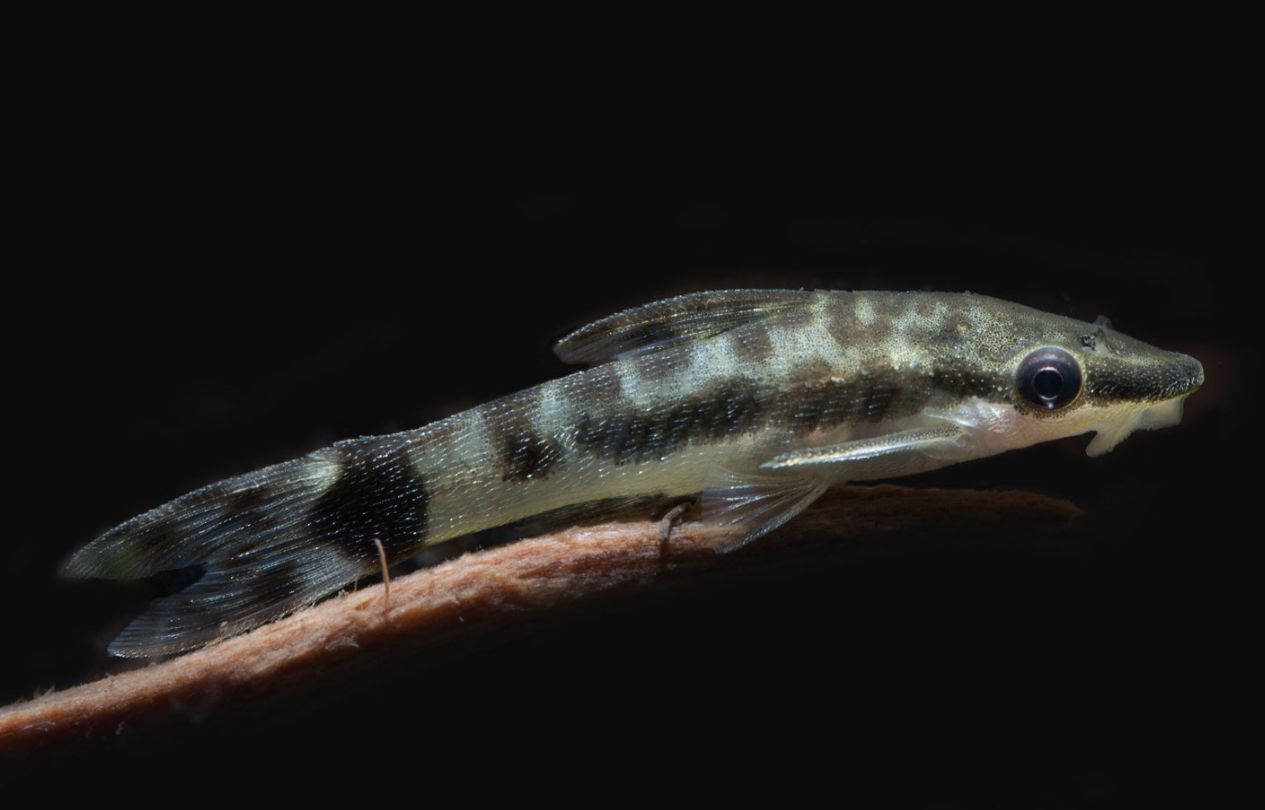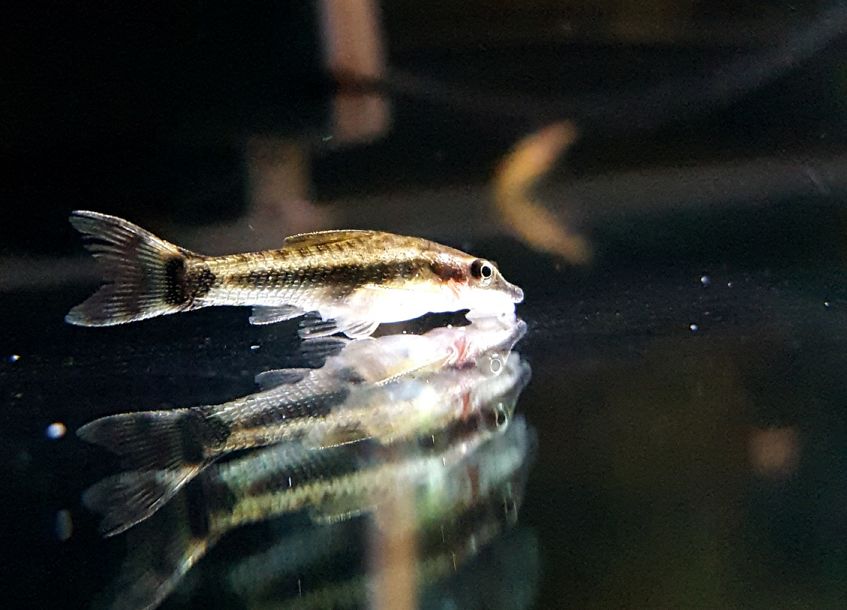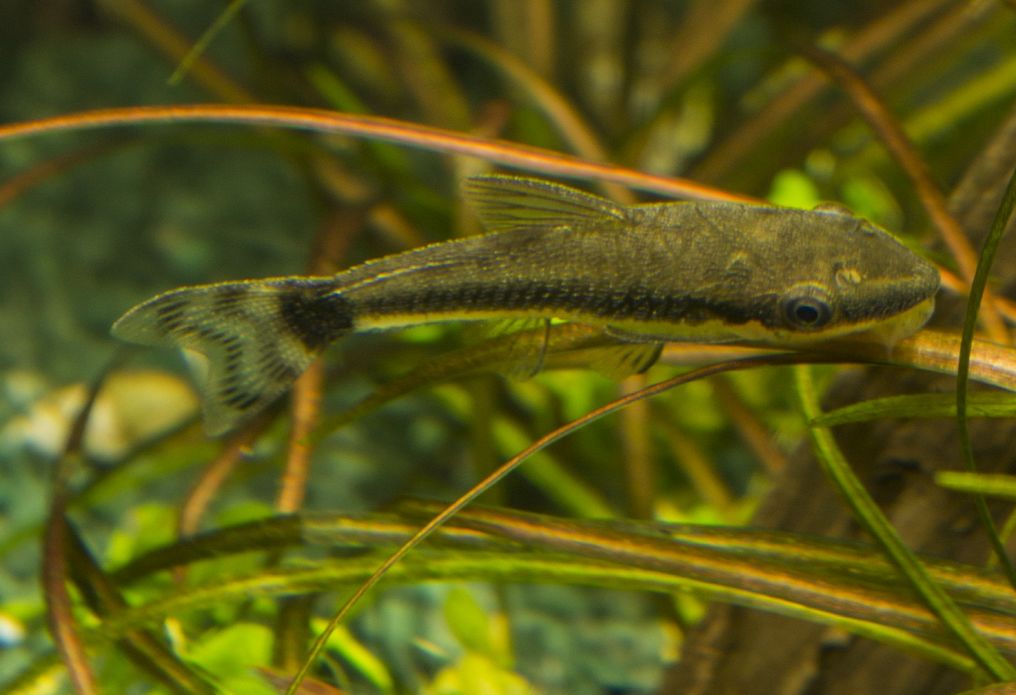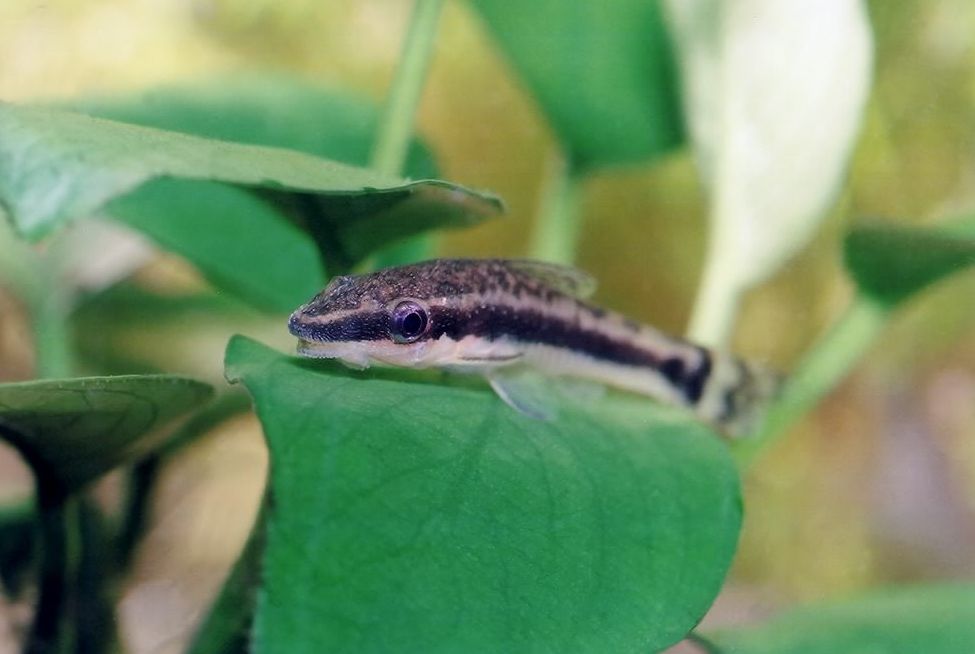Otocinclus is a small, unassuming catfish known for its remarkable efficiency in algae consumption, making it a valuable addition to any aquarium. These fish, often found grazing on algae-covered surfaces, play a crucial role in maintaining a clean and tidy tank. Alongside Amano shrimp, otocinclus help keep both the tank and its plants free from unsightly algae. Their peaceful nature makes them ideal for community tanks, and their presence not only supports tank hygiene but also enhances the overall aesthetic of the aquarium.

Contents
Habitat in the wild
The otocinclus catfish, commonly known as the dwarf suckermouth catfish, belongs to the diverse family Loricariidae, which includes various species with unique sizes and characteristics. Currently, there are about 16 to 17 different types of otocinclus, often sold in pet shops as a single species. Among these, Macrotocinclus affinis and Otocinclus cocama (zebra oto) are the most commonly found. However, a significant portion of otocinclus available on the market is misidentified as Macrotocinclus sp.
These catfish are distributed from Colombia to northern Argentina, originally inhabiting the eastern Andes. Some species have restricted habitats in Peru, Brazil, and Paraguay, while others can be found throughout the Amazon and Orinoco river basin headwaters. Dwarf suckermouth catfish typically reside in small to medium-sized rivers with moderate flow, often nestled among streamside vegetation or swimming in open water above sandy bottoms enriched with tree roots.
Their natural habitat is characterized by dense vegetation, where they thrive on algae and biofilm that develop on submerged and overhanging plants. Otocinclus prefer clear, oxygen-rich waters with minimal currents and are well-adapted to low light conditions, becoming most active during dawn and dusk. In the wild, they form schools to enhance their protection against predators, showcasing their social nature.
Description
Body
The body of the otocinclus catfish is elongated and flattened on the sides, covered with broad bony scales, except for the abdomen, which is unscaled. These fish feature large, expressive eyes and a unique cupule-shaped mouth, which allows them to effectively graze on algae. Notably, otocinclus catfish possess the ability to breathe atmospheric air through intestinal respiration, making them adaptable to varying water conditions.
Their body coloration typically displays a yellowish tint, accented by a prominent black-brown stripe that runs along the length of their body. The fins are transparent and colorless, often with a slight greenish hue. These physical characteristics not only enhance their aesthetic appeal but also play a role in their behavior and feeding habits in the aquarium.
Otocinclus catfish are often mistaken for other species due to their similar appearance, so understanding their physical traits is crucial for proper identification.
Size
Female otocinclus catfish are generally plumper and larger than males, reaching a size of up to 4 cm (1.6 in) in length when kept in aquariums. However, their size can vary slightly depending on the species and individual growth rates. This small size makes otocinclus a popular choice for community aquariums, especially among aquarists with smaller tanks or those who prefer keeping smaller fish species.
Due to their diminutive size, otocinclus are well-suited for nano aquariums or planted tanks, where they play a vital role in controlling algae growth while enhancing the overall aesthetics of the setup.
Lifespan
The lifespan of otocinclus typically ranges from 2 to 5 years when kept in well-maintained aquariums. However, with proper care and a suitable environment, some individuals have been known to exceed 5 years.
| Characteristic | Description |
|---|---|
| Scientific Name | Otocinclus spp. (Several species in the genus) |
| Common Names | Otocinclus catfish, Oto, Dwarf suckermouth catfish |
| Family | Loricariidae |
| Origin | South America, primarily in the Amazon River basin |
| Size | Usually 1.65 inches (4 centimeters) |
| Lifespan | 2 to 5 years or more in well-maintained aquariums |
| Behavior | Peaceful and social, prefers to live in groups |
| Diet | Herbivorous – feeds on algae and biofilm |
| Tank Size | Minimum of 10 gallons for a small group |
| Water Parameters | Temperature: 72°F to 78°F (22°C to 26°C) |
| pH: 6.5 to 7.5 | |
| Hardness: 2 to 15 dGH (soft to moderately hard water) | |
| Tank Setup | Planted aquarium with hiding spots and driftwood |
| Compatibility | Peaceful and suitable for community tanks with non-aggressive fish |
| Breeding | Challenging in captivity and usually occurs in large aquariums |
| Special Considerations | Sensitive to water quality, avoid sharp substrates |

Difficulties in keeping
Despite its small size, Macrotocinclus affinis is quite demanding in terms of care. It requires clean water with stable parameters, making it less suitable for beginners. Ideal conditions include slightly acidic to neutral pH levels and good filtration. However, these oto catfish excel at efficient algae cleaning, outpacing many other fish in this regard
The fish does it all day long – it looks for algae and it doesn’t harm even the smallest and the most tender tank plant leaves, such as Hemianthus callitrichoides Cuba, Glossostigma elatinoides and even Java moss.

Care and keeping in a tank
Tank size
It’s best to keep otocinclus catfish in groups of 5 to 10 for their social well-being. These fish are naturally social and thrive in the company of their own kind. Keeping them in groups helps reduce stress and promotes natural behaviors, such as grazing and schooling. In the wild, they often form schools to protect themselves from predators, so replicating this social structure in captivity is essential for their well-being.
Takashi Amano, a renowned aquarist and designer, recommends a minimum tank capacity of 100 liters (26.42 gallons) for housing around 20 fish, including otocinclus, once the ecosystem stabilizes. This recommendation is based on creating a balanced environment that can support a larger bioload. Proper tank size ensures sufficient space for swimming and hiding, which is crucial for their comfort and health. In tanks that are not densely planted, having 10 otocinclus in a 100-liter setup is considered sufficient. While otocinclus appreciate well-planted environments where they can forage for algae, they can also thrive in less dense setups if their water quality is maintained.
For smaller tanks, such as those with a capacity of 30 liters (7.93 gallons), keeping 4 otocinclus catfish is a suitable option. These fish are adaptable and can do well in smaller environments, provided the water quality is consistently monitored and maintained. Regular water changes and filtration are essential to keep the tank clean and the fish healthy in smaller setups.
Water parameters
Care for all otocinclus species is generally the same, largely due to their small size and sensitivity to polluted water. This intolerance to dirty conditions is a key factor in maintaining their health and promoting rapid growth, especially in tanks with low plant density and excellent water quality.
To achieve this, strong water filters are essential, capable of renewing the entire volume of tank water at least three times per hour. Such filters should ensure the absence of ammonia and nitrites while keeping nitrates between 0 and 20 ppm. Additionally, it’s vital to perform weekly water changes of about 25-30% to maintain stable conditions in the tank.
While the specific chemical composition of the water is less critical, it should always be clean and fresh. Ideal conditions include a temperature range of 21–27 °C (70–81 °F) and a pH that is neutral or slightly acidic. Once these conditions are met, otocinclus catfish will feel at home in the aquarium.
Tank decor
Healthy otocinclus catfish are very active during the day, tirelessly grazing on soft algae from various surfaces within the tank. To support their natural foraging behavior, it’s beneficial to include some pre-soaked oak tree roots, smooth stones, and hardy tank plants. Since otocinclus have relatively weak teeth, they are unable to gnaw on tougher plant materials, so when their supply of fresh algae runs low, they will need additional food to maintain their health.
Creating a model of their natural habitat can greatly enhance their well-being. Incorporating plants with ample leaves and pre-soaked branches into the tank provides both hiding spots and foraging opportunities. A sandy substrate is an excellent choice for the bottom of the tank, as it supports plant growth while allowing fish waste to remain on the surface until the filter can effectively remove it.
Using a high-quality filter with moderate to intense water turnover will help keep the tank water clean and well-oxygenated. This not only maintains a healthy environment for the fish but also promotes overall tank stability, making it an ideal setting for otocinclus catfish to thrive.

Diet
The stomachs of otocinclus catfish caught in the wild are primarily filled with algae and other nutritious organic matter. In an aquarium setting, these fish eagerly consume algae from stones, plant leaves, and glass surfaces. However, otocinclus do not rely solely on algae as their main food source; they should be supplemented with a varied diet to ensure optimal health.
To provide a balanced diet, offer special vegetable foods, including spirulina-based flakes, frozen bloodworms, and gammarids. Fresh steamed vegetables are excellent dietary supplements as well. Varieties like lettuce, spinach, squash, and green peas can be provided once a week overnight. It’s important to remove any uneaten food within two days to maintain water quality; squash tends to be a favorite among these fish.
To prepare the vegetables, boil them for about two minutes or microwave them in a bowl of water for 30 seconds. After cooking, secure the vegetables to a stone or other tank fixture to allow the otocinclus to graze comfortably. This approach not only enhances their diet but also mimics their natural feeding behaviors, contributing to their overall well-being in the aquarium.
Tank mates
When choosing tankmates for Otocinclus catfish, it’s essential to consider their peaceful nature and small size. They are relatively shy and non-aggressive fish, so it’s best to select tankmates that won’t bully or stress them. Additionally, because Otocinclus are primarily herbivores that feed on algae and biofilm, it’s crucial to avoid pairing them with fish that might compete for the same food sources.
Since otocinclus catfish are peaceful, calm, they don’t grow to become a large fish and don’t harm anyone, they are perfect algae eaters, – they are ideal tank mates to any peaceful fish and they are welcome in any tank (for example: serpae tetra, glowlight tetra, black tetra, dwarf gourami, betta fish). The only tank that won’t do for oto cats, it’s a tank with large cichlids (flowerhorn, oscar fish, green terror) or catfish (sailfin pleco).
Here are some suitable tank mates for Otocinclus catfish:
- Harlequin Rasboras (Trigonostigma heteromorpha)
- Neon Tetras (Paracheirodon innesi)
- Ember Tetras (Hyphessobrycon amandae)
- Glowlight Tetras (Hemigrammus erythrozonus)
- Black Neon Tetras (Hyphessobrycon herbertaxelrodi)
- Cardinal Tetras (Paracheirodon axelrodi)
- Rummy Nose Tetras (Hemigrammus rhodostomus)
- Dwarf Gouramis (Trichogaster lalius or Trichogaster chuna)
- Sparkling Gouramis (Trichopsis pumila)
- Celestial Pearl Danios (Danio margaritatus)
- White Cloud Mountain Minnows (Tanichthys albonubes)
- Dwarf Rasboras (Boraras spp.)
- Endler’s Livebearers (Poecilia wingei)
- Guppies (Poecilia reticulata)
- Platies (Xiphophorus spp.)
- Corydoras Catfish (Corydoras spp. – pygmy cory, panda cory, adolfoi catfish)
- Bristlenose Plecos (Ancistrus spp.)
Gender differences: male vs female
Determining the sex of otocinclus catfish can be quite challenging due to the lack of prominent physical differences between males and females. Unlike other fish species where males may exhibit more vibrant colors or distinctive fin shapes, male and female otocinclus generally appear very similar. This similarity makes visual identification difficult, often necessitating internal examination, which should only be performed by experienced aquarists or professionals.
Males possess a genital papilla and rows of modified denticles (odontoids) located on the underside of the tail stem, where the body transitions into the tail. The exact function of this organ is not fully understood, but some specialists believe it plays a role in copulation, aiding male orientation as he embraces the female’s head during mating.
For most hobbyists, the sex of otocinclus catfish is not a critical factor, as they are typically kept in groups rather than specific breeding pairs. When acquiring otocinclus for your aquarium, it’s advisable to purchase a group of five or more to ensure social interaction and a thriving community, rather than attempting to identify specific genders.
Breeding
Breeding otocinclus catfish is considered a challenging process. While these fish have been bred in captivity, such occurrences are still relatively rare. Although distinguishing between males and females can be tricky, maintaining a group of otocinclus increases the chances of successful breeding.
To stimulate spawning, it’s important to provide a diet rich in protein. Offering live food several times a day can help encourage the fish to spawn. Prior to spawning, there is typically a lengthy courtship period that includes interactions such as fighting and preparing a suitable spawning site.
Creating a conducive environment for breeding involves ensuring optimal water conditions, including clean water and appropriate temperature ranges. By focusing on diet and social structure, aquarists can increase the likelihood of successful breeding among otocinclus catfish.